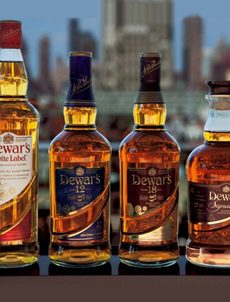FATHER’S DAY GIFT IDEA: Blended Scotch Whisky
|
Last night we learned how to blend Scotch, courtesy of America’s best-selling Scotch brand, Dewar’s.
A few decades ago, when single malt Scotch became all the rage, we became a snooty single malt drinker and hadn’t drunk a blended Scotch until now. We were missing out! Single malt versus blended Scotch is purely a matter of preference, and one can prefer several different styles. SINGLE MALT SCOTCH A single malt Scotch is made entirely by a single producer at a single site. The flavors and aromas are distinctive to the terroir* of the area. Each of the different regions of Scotland produces whisky with flavors and aromas unique to its climate, water and so forth. For example, over the years of aging, barrels on Islay, an island region, pick up a hint of saltiness from the sea. ___________________ |
 The four expressions of Dewar’s blended Scotch whisky. From left: White Label, 12 Years, 18 Years and Signature. Photo courtesy Dewar’s. |
|
|
BLENDED SCOTCH Blended Scotch created by mixing the distillations (Scotches) from multiple single malt producers. By selecting particular single malts, the blender can achieve the exact flavor combination desired, with more balance and complexity. Examples include honey and floral flavors from Highland Scotches, fruity flavors from Speyside, vanilla flavors from Lowland Scotches and peaty flavors from Islay. Dewar’s blends can contain up to 40 different single malts and grain whiskys (a whisky that contains some grains other than malted barley, such as corn, rye or wheat) to attain the perfection the blender seeks. The proper glass† to “nose” Scotch is a sherry copita, also called a single malt whisky glass. It resembles a tulip, and can be used for any fine whisky. The lip turns outward to catch the aromas of the whisky. Why is it there so often a gap between our preferences and our pocketbook? While all of the Dewar’s expressions are very fine, we fell in love with the masterpiece of the portfolio, Dewar‘s Signature (upwards of $200). The nose burst with aromas of luscious Seville orange and a touch of peat. On the palate, orange and chocolate notes were accented with honey, vanilla, toffee and caramel overtones. It was dessert in a glass, and a real treat. For everyday, we’re going back to the very affordable Dewar’s 12 Years—which, by the way, is also made in a kosher expression: Dewar’s 12 Year Old Special Reserve. ___________________ In Ireland and the United States, the word “whiskey” is spelled with an “e.” The British, Scots and Canadians spell it “whisky.” To be perfectly correct, you’d use “whiskey” when referring to an Irish or American product; and “whisky” when referring to the others. But most people in the U.S. use the spellings interchangeably. Etymologists don’t know why the variations exist. The best explanation is that the Irish had whiskey first, and when the Scots started to make it, they left out the “e” to point out the difference between their spirit and Irish whiskey. We’ll drink to that! By the way, April 6th is Tartan Day in Scotland. It commemorates the Scottish Declaration of Independence, upon which the American Declaration of Independence was modeled. Raise a glass of Scotch, toast and enjoy! How many types of whiskey are there?
|
||


